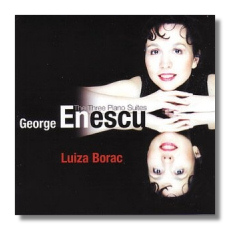
The Internet's Premier Classical Music Source
Related Links
- Enescu Reviews
- Latest Reviews
- More Reviews
-
By Composer
-
Collections
DVD & Blu-ray
Books
Concert Reviews
Articles/Interviews
Software
Audio
Search Amazon
Recommended Links
Site News
 CD Review
CD Review
George Enescu

Suites for Solo Piano
- Suite #1 "Dans le style ancien" in G minor, Op. 3
- Suite #2 in D minor, Op. 10
- Suite #3 "Pièces impromptues", Op. 18
Luiza Borac, piano
Avie AV0013 DDD 79:06
Also released on Hybrid SACD:
Amazon
- UK
- Germany
- Canada
- France
- Japan
- ArkivMusic
- CD Universe
A musician's musician, composer George (or Georges) Enescu (or Enescu) is known the world over for two tuneful but rather atypical works – namely the First and Second Romanian Rhapsodies – splashy orchestral potpourris in a "pops" style. Yehudi Menuhin – a musician's musician himself – practically worshipped the ground upon which he walked. One of the finest violinists of the past century, Enescu was also a brilliant pianist, a fine conductor, and a genius whose memory for music rivaled that of Wolfgang Mozart. Like Mozart, he also died in poverty. He was born in 1881 and died in 1955.
Unlike Mozart, Enescu was not a terribly prolific composer. He published less than a few dozen of his works; there is much that remains in manuscript, however. The piano plays a prominent role in most of his chamber music, but seldom as a solo instrument. Apart from these three suites, there are two piano sonatas and just a handful of smaller works.
The First Suite was written in 1897, the Second between 1901 and 1903, and the third (posthumously published) is made up of seven shorter pieces written between 1913 and 1916. Heard in sequence, they aptly trace the full and bizarre flowering of Enescu's genius as a composer. Enescu's early works are intriguing and odd; the late ones are practically visionary.
The First Suite, written "in the old style," is neo-Baroque. It picks up where the first movement of Saint-Saëns's Second Piano Concerto left off. One feels the intrusion of pastiche into Saint-Saëns's concerto, however; the fifteen-year-old (!) Enescu has, in contrast, assimilated Bach and other Baroque masters into his First Suite, marking them with already distinctive fingerprints. Enescu returns to Baroque models in the Second Suite, assimilating them even more completely. Tellingly, Enescu subtly instills the music with melancholy echoes of his Romanian homeland. A French influence is felt more strongly here too. (This should be no surprise, as Enescu entered the work into a competition judged by the likes of Debussy, Cortot, and d'Indy. And oh yes, the composer won the Pleyel prize – and a coveted Pleyel piano! – for his troubles.) The Third Suite was assembled after his death from manuscripts. Here, Enescu seems to be pushing Debussy's and Ravel's piano music into hyperspace, and not just with titles such as "Carillon nocturne," an eyebrow-raising yet gorgeous exercise in polytonality. The melding of Impressionism, neo-Baroque writing, and Romanian nostalgia in these three suites is unique and extremely rewarding. More pianists need to pay attention to these unusual works.
The pianist, apparently still quite a young woman, was born in Romania where she quickly gained acclaim first in local then in national – and later, world-wide – competitions. She has concertized extensively in the United States and in Europe. Her tone is luminous and full – the first thing a listener notices. Enescu's alarmingly difficult writing seems to leave her pianism a little short of sweep at times, but this is impressive playing by any standards, and the interpretations are full of fancy. I hope other pianists follow Borac's example and give these works a try. The recording balances warmth and brilliance, and the booklet notes are helpful, given the unfamiliarity of the music.
Copyright © 2003, Raymond Tuttle




















